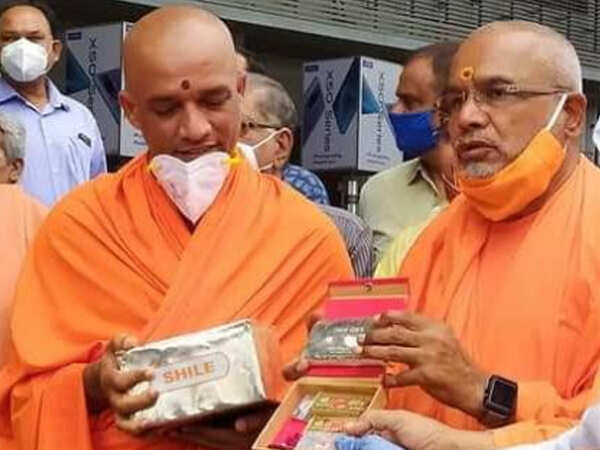


His guru was Jagadguru Sri Abhinava Vidyatirtha Mahaswami. The present and 36th Jagadguru acharya of this peetham is Jagadguru Bharathi Teertha Mahaswami. The math has a lineage of Jagadgurus, stretching back straight to Sri Adi Shankaracharya himself. The math holds one of the four Mahavaakyas, Aham-Bramhasmi. Sri Adi Shankara installed Sri Sureshwaracharya, believed to be the same as Maṇḍana Miśra, as the first acharya of the Peetham at Sringeri before resuming his tour to establish the three remaining Peethams at Puri, Dwaraka and Badarinath. Sringeri is independently associated with Sage Rishyasringa of Ramayana fame, son of Sage Vibhandaka. Deducing that non-violence amongst natural predators was innate to a holy spot, Sri Adi Shankara decided to establish His first Peetham in Sringeri. He also instituted the tradition of appointing a succession of monastic pontifical heads, called the Jagadgurus, to each of the four monasteries, installing Sri Sureshvaracharya, Sri Hastamalakacharya, Sri Padmapadacharya and Sri Totakacharya as the first Jagadgurus of the Peethams at Sringeri, Dvaraka, Puri and Badri respectively.Įstablishment by Sri Adi Shankara Ī hagiographic legend states that Sri Adi Shankara, during His travels across India, witnessed a snake unveiling its hood like an umbrella to shield a pregnant frog from the hot sun on the banks of the river Tunga in Sringeri. These were Sringeri Sri Sharada Peetham (Karnataka) in the South, Dvārakā Śāradā Pītham (Gujarat) in the West, Purī Govardhan Pīṭhaṃ (Odisha) in the East and Badri Jyotishpīṭhaṃ (Uttarakhand) in the North. Sri Adi Shankaracharya, the principal exponent of Advaita Vedanta, established four pithams (dioceses) in India to preserve and propagate Sanatana Dharma and Advaita Vedanta. Sringeri can be accessed from Bangalore and Mangalore via road.

Sri Sharada Peetham is located in Sringeri about 85 kilometres (53 mi) east of Udupi and 100 kilometres (62 mi) northeast from Mangaluru across the Western Ghats, and about 335 kilometres (208 mi) west-northwest from the state capital, Bengaluru. 2.5.1 Maratha sacking the temple in 1791.The Pītham has branches across India and maintains temples at several locations. Along with other Hindu monasteries, the Śringerī Mutt has been active in preserving Vedas, sponsoring students and recitals, Sanskrit scholarship, and celebrating traditional annual festivals such as Śaṅkara Jayanti and Guru Pūrnima (Vyāsa Pūrnima). The Pītham runs several vedic schools (pathashalas), maintains libraries and repositories of historic Sanskrit manuscripts. The Pītham is one of the major Hindu monastic institutions that has historically coordinated Smārta tradition and monastic activities through satellite institutions in South India, preserved Sanskrit literature and pursued Advaita studies. The Pitham has conflict with other Sringeri mutt named Koodli Sringeri Sharada Peetham, which claims to the be the original mutt and calls Sringeri Sharada Peetham as Tunga Sringeri Sharada Peetham The current pontiff, Śrī Bhārathī Tīrtha Svāmin is the 36th Jagadguru in the since-unbroken spiritual succession of pontiffs. The first pontiff of the Pītham was Śrī Ādi Śaṅkara's eldest disciple, Śrī Sureshvarāchārya, renowned for his treatises on Vedānta - Mānasollāsa and Naishkarmya-Siddhi. The Pītham is traditionally headed by an ascetic pontiff belonging to the Dashanāmī order of monasticism, the Jagadguru Śankarāchārya. The southern bank houses the residence of the reigning pontiff, the adhisthānam shrines of the previous pontiffs and the Sadvidyā Sañjīvini Samskrita Mahāpāthashālā. The three prominent shrines on the northern bank of the Tunga are dedicated to the presiding deity of the Pītham and the divinity of Ātma-vidyā - Śrī Śāradā, Śrī Ādi Śaṅkara, and Jagadguru Śrī Vidyāśankara Tīrtha, the 10th Jagadguru of the Pītham. The Mutt complex consists of shrines on both the northern and southern banks of the river. Śri Śringerī Mutt, as the Pītham is referred to in common parlance, is situated on the banks of the Tuṅgā River in Śringerī. Located in Śringerī in Chikmagalur district in Karnataka, India, it is the Southern Āmnāya Pītham amongst the four Chaturāmnāya Pīthams, with the others being the Dvārakā Śāradā Pītham (Gujarat) in the West, Purī Govardhana Pīṭhaṃ (Odisha) in the East and Badri Jyotishpīṭhaṃ (Uttarakhand) in the North. Dakṣināmnāya Śrī Śāradā Pītham or Sri Sringeri Mutt is one amongst the four cardinal pīthams established by acharya Śrī Ādi Śaṅkara to preserve and propagate Sanātana Dharma and Advaita Vedānta, the doctrine of non-dualism.


 0 kommentar(er)
0 kommentar(er)
